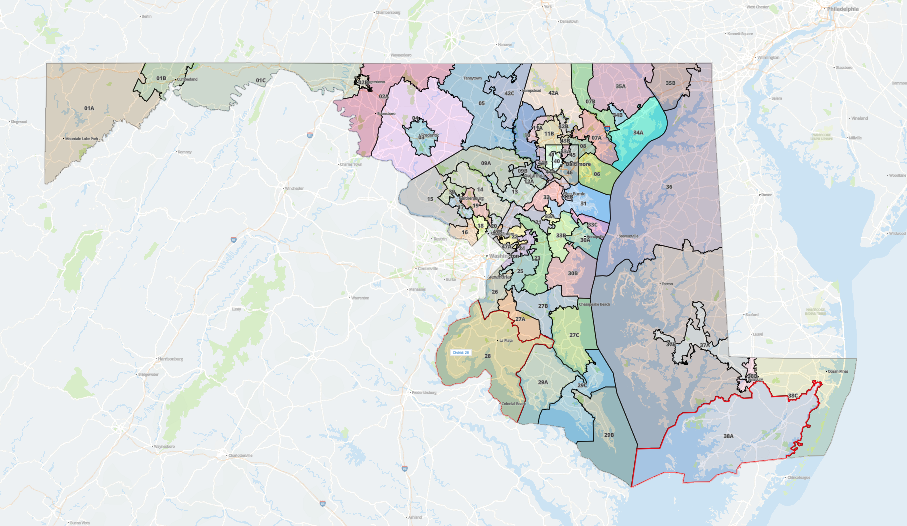
This article was republished with permission from WTOP’s news partners at Maryland Matters. Sign up for Maryland Matters’ free email subscription today.
This content was republished with permission from WTOP’s news partners at Maryland Matters. Sign up for Maryland Matters’ free email subscription today.
Maryland senators advanced a legislative redistricting proposal Tuesday that could help vulnerable Democrats in the upcoming election and did not vote on a separate proposal by a panel that Republican Gov. Lawrence J. Hogan Jr. convened.
The redistricting plan that the Senate Reapportionment and Redistricting Committee advanced in a party-line 11-4 vote Tuesday afternoon was proposed by the Legislative Redistricting Advisory Commission, a panel convened by Senate President Bill Ferguson (D-Baltimore City) and House Speaker Adrienne A. Jones (D-Baltimore County).
The vote came after a joint hearing by the Senate committee and the House Rules and Executive Nominations Committee.
A proposal from the Maryland Citizens Redistricting Commission — to which Hogan appointed Republicans, Democrats and unaffiliated voters to draw legislative maps — wasn’t taken up for a vote.
The move to advance the Legislative Redistricting Advisory Commission proposal and leave the Maryland Citizens Redistricting Commission proposal in committee mirrors Democratic lawmakers’ strategy on congressional redistricting during a special session in December.
The favorable committee vote means the Legislative Redistricting Advisory Commission’s proposal could head to the Senate floor sometime this week. Lawmakers used existing districts as a baseline for that map, although the proposal does include some noteworthy changes.
Lawmakers added a single-member majority Black district in Baltimore County to comply with the federal Voting Rights Act, shifted District 9 in Howard County to include part of northern Montgomery County rather than southern Carroll County, and reduced the number of full senatorial districts in Baltimore City to account for population losses over the past decade.
One shift around Frederick County in the Legislative Redistricting Advisory Commission’s proposal drew scrutiny from a Democrat on the Senate Reapportionment and Redistricting Committee, Sen. Ron Young (D-Frederick).
The city of Frederick would be contained within a three-member delegate District 3 encircled entirely by District 4 in the Legislative Redistricting Advisory Commission’s proposal. Currently District 3 includes the city, extends south to the Potomac River and is split into two subdistricts, with most of the city in a two-member subdistrict and the area southeast of the city in a single-member district.
“I didn’t see a reason to change that,” Young, who represents the 3rd District, said.
House Majority Eric G. Luedkte (D-Montgomery County) said the “constitutional default” in Maryland is a three-member delegate district, and said the change was warranted given Frederick’s rapid growth over the last decade. Young eventually voted to advance the map.
Hogan was constitutionally required to begin the legislative redistricting process by submitting a map to the General Assembly. That district map becomes law if legislators don’t make any changes within 45 days. In written testimony, Hogan said his Maryland Citizens Redistricting Commission’s maps were “free from political influence and offer the opportunity for fair elections in Maryland.”
Hogan noted that population deviations are kept to a minimum in the Maryland Citizens Redistricting Commission’s maps. While legislative districts are allowed to have a plus or minus 5% deviation from the target population, that panel’s maps keep population deviation to less than 2% for senatorial districts and less than 3% in delegate districts.
The Legislative Redistricting Advisory Commission map keeps population variances to plus or minus 4%. At a public hearing last month, Karl Aro, chair of the legislative redistricting panel and a former head of the nonpartisan Department of Legislative Services, said that figure is smaller than any legislative maps he worked on during his tenure at the Department of Legislative Services.
Sen. Mary L. Washington (D-Baltimore City) questioned the independence of the Maryland Citizens Redistricting Commission, since Hogan created it by executive order and, to some extent, told them how to craft the map, including mandating that commission members not consider where incumbents live or voters’ party affiliation when drawing up districts.
“That implies to me that the governor was drawing the map,” Washington said of the executive order’s requirements.
Maryland Citizens Redistricting Commission Co-Chair Walter Olson (R) said the executive order didn’t require the commission to “consider the wishes of the governor or anyone in his office,” and added that panelists also considered the U.S. and state constitutions and federal law.
“When we were told to ignore the interests of incumbents, by golly, we ignored the interest of incumbents,” Olson said. “That’s something [the Legislative Redistricting Advisory Commission] was not told to do, and presumably also did not do.”
The Maryland Citizens Redistricting Commission opted to start from scratch rather than work with existing districts, but the lawmaker-dominated Legislative Redistricting Advisory Commission generally aimed to keep districts intact.
“These districts have been around a long time, some for many years, some for decades, and by the very existence of them lasting that long they basically have created a communities of interests,” Aro said.
Election officials who testified said that lawmakers should move quickly to enact new maps, since local boards of elections are already short on time to reconfigure precincts and educate voters before this year’s June primary election.
“There is a lot of work that needs to be done in order for the precincts, the polling places, the election judges, et cetera to be ready for the election,” David Garreis, president of the Maryland Association of Election Officials, said.
An interactive version of the Legislative Redistricting Advisory Commission’s legislative redistricting proposal can be found online here.







